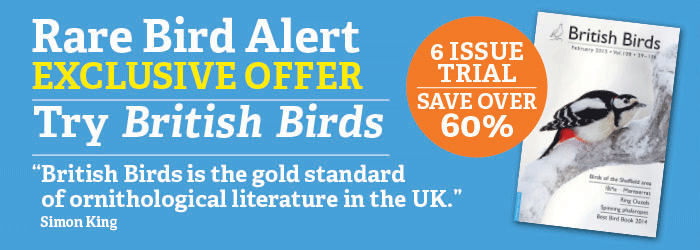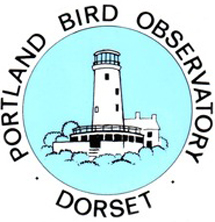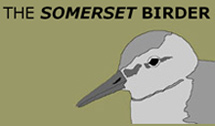Weekly round-up: 06 - 12 May 2015 sponsored by British Birds
So many birds, so much weather too…
The week began with strong and pretty chilly southwest winds zipping across from the Western Approaches to the far east coast - but despite the breezy conditions there was sunshine a plenty.
It didn’t take long for the winds to ease back, bringing a short spell of southeasterlies for some, the high pressure and somewhat moist atmosphere combining for fog in places and clear blue skies on others. Contrast was key.
The weekend brought more settled weather (once a band of wet weather had passed across the country from the southwest) and increasingly warm conditions with southerly winds. Temperatures rose to the low 20’s in some parts of southern England but as the week drew to a close, the brisk westerly winds eased and the evening of 12th saw calm conditions set in, clear skies and bright sunshine seemingly the order of the last couple of hours of the week.
Seven days ago, the collective air was one of great birds but with no real hints of springs past. The past week have most certainly upped the ante - as if you needed telling - as May delivered a couple of absolute crackers.
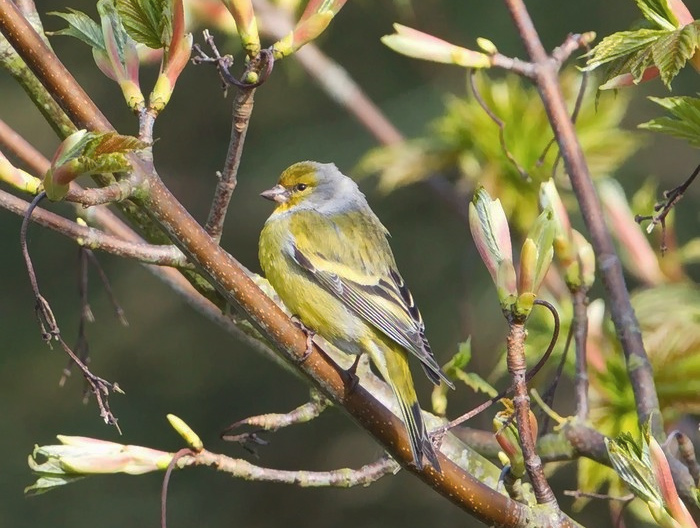
May 10th…hmmm….May 10th….what’s there been on May 10th?
A whole host of ornithological goodies is what but none of them can compare with the huge rare found in the sandy hills’n’hollows of the far east end of Burhham Overy Dunes, within the looming shadows of the extreme west end of Holkham Pines on May 10th 2015.
The role-call of honour for the tenth day of our fifth month is wide, varied and long. From Bufflehead to Barolo Shearwater, the list meanders through the rares like a pretty running river - taking in both Little and Baillon’s Crake, two relatively recent Kent pratincoles (one Collared, one Black-winged), Terek Sandpiper and Greater Yellowlegs, two Little Swifts and single Calandra Lark and Spectacled Warbler along with three species of Nearctic passerine, topped off by a Brown-headed Cowbird…
A mighty, mighty list of rare birds, really rare birds, and that list of outstanding finds across the May 10th’s of yore can now add perhaps the best of all to the top of the tree - male Citril Finch.
Only the second British record, coming just a month short of seven years after the remarkable discovery of the twitched adult male on Fair Isle (in early June 2008), this was truly a bird to stir birders from their Sunday morning slumbers.
The story of the occurrence can be seen here - thankfully after the first little flurry of the fleet-of-foot (and phones) had seen it, the bird began an edgy game of cat & mouse, moving between the expansive dune slacks and the imposing vast pine tree system to the west in the first couple of hours after the bird was Mega’ed at around 0915 (around 90 minutes after the first brief sighting).
A couple of false starts with a couple of single Siskins heading over towards Scolt didn’t help alleviate any of the rising tension - for all sorts of reasons - until just around 11am, a time that heralded the first confirmed sightings since around half past nine - the bird and seen in and around the “Moltoni’s bushes”, flying up and showing to all the 80 or so people stood around the sand-bedecked amphitheatre.
More flight views would follow and then, for the first time since early doors came the views “on the deck”. Restrained bedlam and pandemonium saw many people enjoy brief-ish views of the bird as it hopped around the sandy hollow close to the pines. The bird showed off-and-n through to just before noon and promptly went AWOL once more…
With newcomers gnashing teeth and gnawing fingernails rapidly down to the quick, the bird remerged - just like the Shopkeeper in Mr Benn - quietly and without any hint whatsoever back in the “Moltoni’s bushes” where it was watched for a few moments before heading back towards the dunes and bushes on the edge of the pines - and this is where it gave itself up for real! On show for at least 15 minutes, the bird performed supremely well, as the whirr of camera shutters and gentle elation cut across the warm Norfolk spring air.
…and so the pattern was set for the remainder of the day - the Citril Finch would show nicely for a while somewhere adjacent to the pines, feeding well and performing delightfully, before taking itself away to the pines for some respite. A little while later, out it would pop once more to repeat the cycle and it would show frequently (and very well) throughout much of the rest of the day.
Early risers on Monday managed a few views, mainly good, though mainly brief until just before 6.30am when it flew from the edge of the pines and away in to the dunes and much further after that too - that was the last sighting, so Scolt Head Island and beyond would seem to be the next destination for this wayward wanderer.
With that truly remarkable find, Norfolk finally has a Citril Finch gifted to it - for almost 90 years the species’ place on the British List came courtesy of a ”Citril Finch” that was taken alive on the North Denes, in Yarmouth in late January 1904. Caught by Mr. John Quinton, the adult female was kept for a couple of days by a Mr. Edward Saunders before being sent to John Henry Gurney in Norwich for identification.
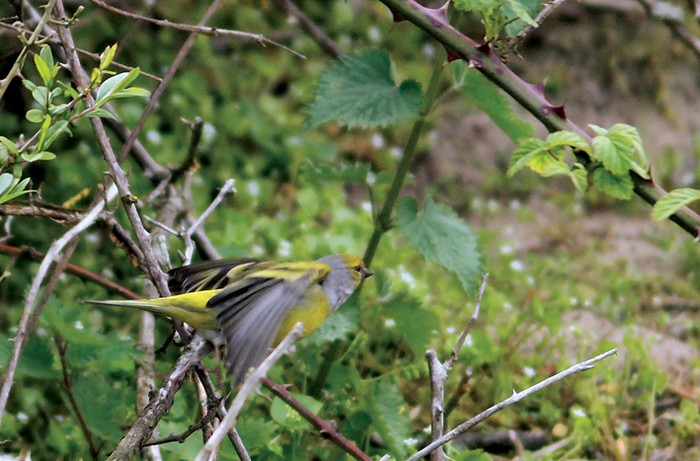
Following the examination by Gurney, the bird was soon admitted to the British List (no mucking about back then) and was mounted by local taxidermist Thomas Gunn and the specimen quickly found itself in to the collection of Sir Vauncey Harpur Crewe in Derbyshire - where it remained until his death and, after auction ion the mid 1920’s, it found itself in the Booth Museum in Brighton where it remained in to the mid-1990’s at least.
The bird was finally photographed in 1989 by Yarmouth’s legendary birder Peter Allard who was researching a book on the local area’s avifauna. Still in the original case, the ”Citril Finch” and several features rang alarm bells with Pete. The images he took of the skin eventually found their way to Lee Evans, who immediately suspected a Canary of some sort was involved and then Dr. Alan Knox (then representing the BOURC) was made aware of the situation and, after visiting the Booth Museum, he removed the specimen to the British Museum in Tring, where finally Yarmouth’s ”Citril Finch” identity was confirmed - it was actually a male Cape Canary.
Citril Finch was officially removed from both the Norfolk and British Lists in 1993 - now, 22 years on, thanks to Marcus Nash, it will return to the former…
…the return to the latter, the all-important British List, came as no-less-of-a-surprise when a (presumed) adult male made a shocking and utterly unexpected appearance at The Haa, at the southern end of Fair Isle on June 6th 2008. The bird remained around the island until 11th - drawing in numerous plane-loads from Shetland and rather farther beyond too - those long haul listers taking quite the gamble given the species’ apparent short-range migration which generally focuses on altitudinal routes up and down mountains.
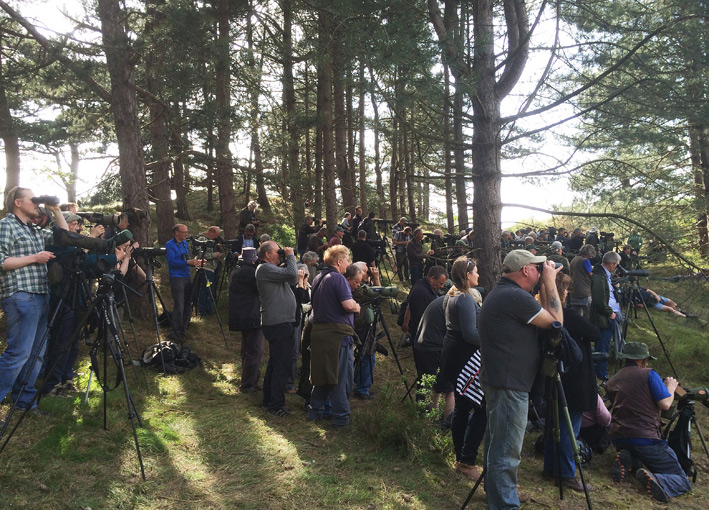
During the rigorous examination of the Fair Isle Citril Finch file (one which had many people feeling sure that the species was never making it to the British List…a thought which didn’t take the pace off of their turn of foot through the dunes in Norfolk this weekend…) it was freely admitted that this was a bird that really wasn’t a likely vagrancy candidate given that seasonal montane climbing and the “resident breeder” status in southern Europe.
As was noted at the time of Category A acceptance, the learned BWP quoted a figure of 615 kilometres as the longest recorded Citril Finch movement; the Fair Isle bird clocking up closer to 1500 from the nearest breeding ground to Shetland (going to 2000 kms if the bird came across the Pyrenees. It was also established that this was a rare species in captivity in Europe - just 25 pairs recorded at the time of the Fair Isle bird’s appearance - and it was also noted that there was a history of extralimital records in southern and central Europe along with a (Category D) record from Finland; a Citril Finch spending some of May and June 1995 in the country, arriving with Siskins (one of which had, tellingly, been ringed near Rome earlier the same year).
All of that evidence and the bird’s perfect condition meant that the return of Citril Finch to Category A was assured.
…and to the undoubted chagrin of some of the Fair Isle twitchers, May 10th 2015 saw this cute-as-can-be, perky little yella’n’green finch take on a status that regular readers may well have become familiar with of late - Citril Finch was now an unblocked blocker, swiftly removed from a number of Blocker-Lockers. What a nice feeling when it isn’t you suffering that little particular happening!
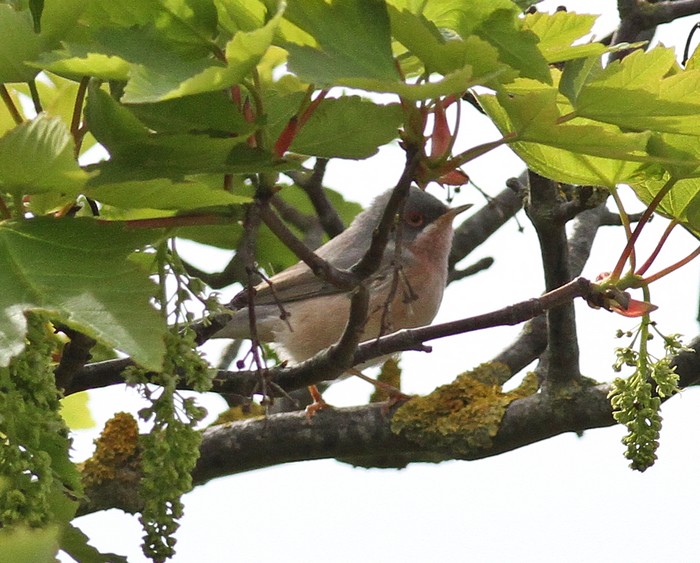
Norfolk then stole the Shetland crown where Citril Finch was concerned. Then, as if by magic, the same county went and did it all over again with another “Shetland special” just over 24 hours later, on the morning of 11th - this time courtesy of a rattling male Moltoni’s Subalpine Warbler in the Plantation on the National Trust reserve on Blakeney Point.
This super Sylvia subalpina spent some while grovelling around a tangle of bramble and spindleberry under and around the imposing sycamore tree within the Plantation before relocating to the nearby tamarisks around the old laboratory. Here it showed incredibly well - calling too for the new arrivals - before drifting back towards the original “find spot” behind the wire of the Plantation.
Here it remained, mainly elusive though sometimes showing nicely, for much of the remainder of the day - a second “lifer” within two days for many and a second Norfolk tick too for those of that particular listing persuasion.
…and keeping it company, a striking female which appeared to be a contender for a Moltoni’s Subalpine Warbler too - though proving that is far harder, the processes involved in confirming that are still to really be defined, a female Western-type being a huge issue…
She was the bird that got the morning’s proceedings rolling along, seen briefly at around 9am, in the same spot that the male popped into later in the morning. She had the distinct air of matching in appearance - bar a bit more powder-blue above - the look of the known female Moltoni’s that was logged on Fair Isle from May 16th-27th last spring - the DNA analysis confirming the bird’s identity (it was initially thought to have been a female Western - as mentioned in the previous paragraph, the field ID of the new species remains testing where such females are concerned).
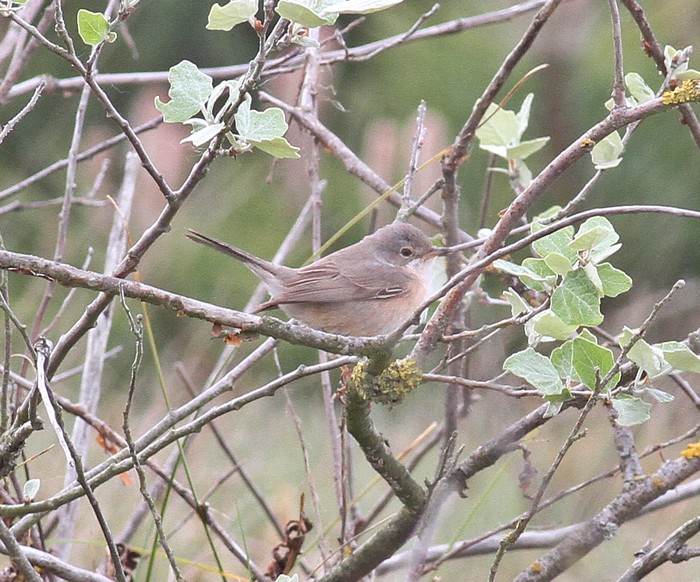
It wasn’t too long ago that here within the review the whole complexed complex of where we were heading with the Subalpine group was looked at - here’s an outline of what was written here a month ago, following on from the East/West carry-on in Cornwall.
... now the BBRC has laid out new taxonmic guidelines following the splitting of Moltoni’s Subalpine Warbler (Sylvia subalpina).
The hoped for three-way multi-split of these beautiful little warblers never happened and what was once Western Subalpine Warbler (cantillans) has now become Western Subalpine Warbler (iberiae & inornata), while cantillans is now within the Eastern group alongside the regular albistriata.
The acceptance of the Fair Isle female was nothing more than a formality and it could become only the fourth British record to date (see the others mentioned below) - the first (and only) accepted bird before the recent Shetland trio came from the skin of a male collected as a specimen on St. Kilda in June 1894, plumage and genetic analysis confirming, beyond doubt, that it was male Moltoni’s Subalpine Warbler.
Further positive records include two sound-recorded males - both on Shetland in the spring of 2009, at Scatness (May 22nd-28th) and on Unst, at Skaw (from June 1st-10th) - which seem to have met with the approval of BBRC, so becoming #2 and #3 for Britain, while the Fair Isle female was given the thumbs-up in March.
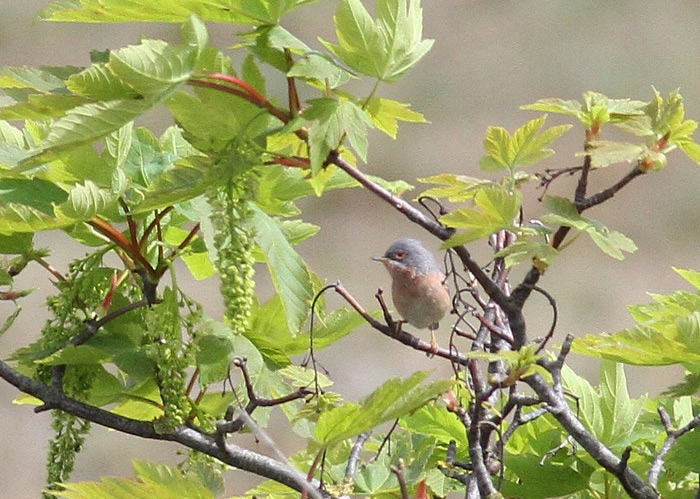
Still residing in the Work-in-Progress file, last spring’s male seen and heard near Green Bay, on Bryher - a bird which, like the Fair Isle female was found on the 16th.
Rumour has it too that Ireland may be about to notch up a “first” one soon and others may end up being submitted too - perhaps the “putative” male at Porthgwarra last autumn being amongst them?
Just how rare or scarce this particular new species is remains something of a hot topic - and just when one of those fetching equally soft-toned autumn males makes the grade is the next step forward in terms of identification skills (be it the PG bird, the Burnham Overy Dunes bird or even, from donkey’s years ago, that remarkably striking thing at Landguard).
Either way, this particular Norfolk pair of voyagers from the Balearics, Corsica, Sardinia or northern Italy (somewhere perhaps adjacent to a Citril Finch…) made quite an impact on a warm, sunny but breezy Monday in north Norfolk. Tuesday however, was a “no show”, but disappointment may be short-lived - this may be a species commoner than we think.
…this week’s two (three!) remarkable East Anglian birds that confirmed, should it ever have been needed to be said again, the popular old adage held amongst local birders of “everything comes to Norfolk eventually” - yup, case upheld your honour. Again.
Truly, there’s nowhere quite like Norfolk…what an astounding 24 hours that was…
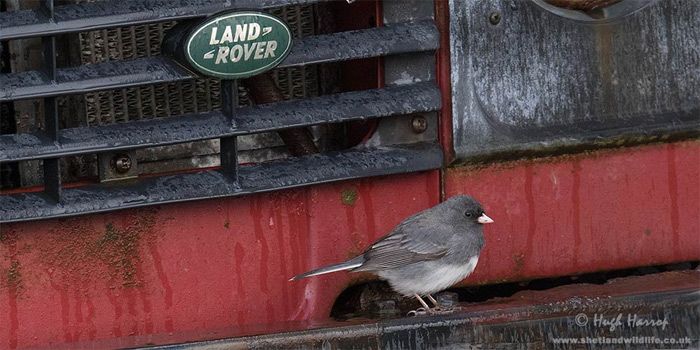
While all eyes (along with accompanying bins and ‘scopes) were all trained on the outstanding rares of a small stretch of the north Norfolk coastline - birds which were Shetland rares really - the far-flung islands decided to liven things up a little bit more by delivering a rather handsome male Slate-coloured Junco to the gardens of Toab, on the southern end of Mainland - the fifth for Shetland and the first since May 2003.
May is plainly the one and only month for the species on the islands - the first for the awesome archipelago was found on May 1st 1966 on Foula and was followed, just over a year later, by another male on the same island, seen on May 10th 1967. Shetland’s third made itself known on Out Skerries on May 7th 1969 (all three being one-day wonders too) and it wasn’t until that previously mentioned bird (a first-winter male) rocked up on (again) Out Skerries from May 1st-9th 2003 that most Shetland listers had chance to enjoy this cracking Nearctic visitor.
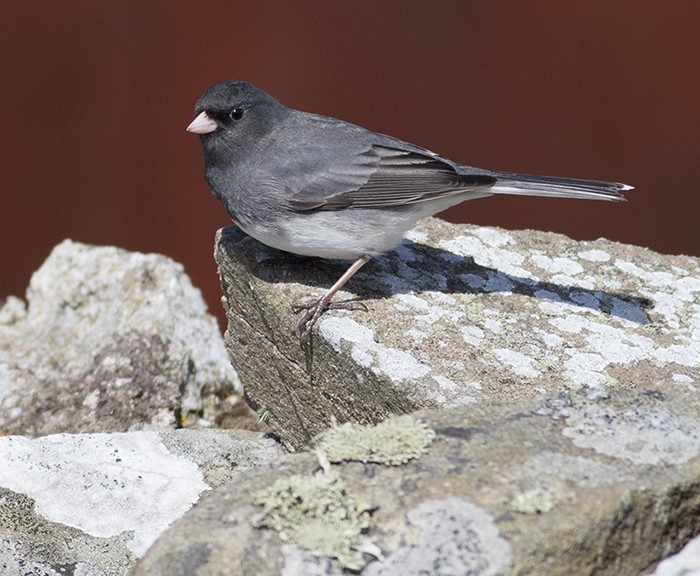
This week’s fine looking specimen becomes the 45th record for Britain and Ireland and the first one since the wintering male in the New Forest, at the Hawkshill Inclosure between December 24th 2011 to February 1st 2012.
One final little “stat attack” before we lurch headlong to Scilly - May now boasts a remarkable 23 records of Slate-coloured Junco - nine of them noted since 2000 (including three “at-sea” acceptances) with the first record anywhere falling to our favourite spring month - shot on the Loop Head Lighthouse (Co. Clare) on May 30th 1905.
Y’know, there’s really nothing like being awoken from some much needed snoozy-snoozy post-dip time by a phone call that sends tremors of anxiety through the brain and that was the deal for me this week, after a spectacular (largely for all the wrong reasons) couple of days on Scilly…
…a Scilly that was surprisingly bereft of the big’n’beefy Great Blue Heron - after enduring the hefty, chilly winds of 6th, it appears that the first-winter traveller from a far decided (after an all-day preening session) to up, up and away from the islands to a new location - goodness knows where that may be…it doesn’t seem to be Bryher or Tresco either and certainly not anywhere else on St. Mary’s, so where next? West Cornwall? Maybe Devon or Dorset? Or what about west Wales or Cork or Wexford?
This superb British second spent 23 days and last week’s prophetic words, well…it was like hoofing myself - really hard - in my own cojones, with my own trusty size 12 boots on…
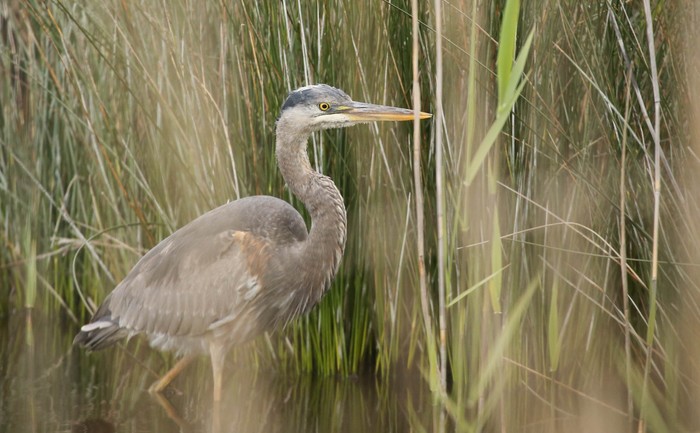
Without wishing to tempt fate too much, it does (increasingly) feel as though maybe this striking first-winter bird could well be around the islands for the duration. Two weeks down (and counting) and, despite all that mooching around, the Great Blue Heron is still in and around Scilly and the odds on it staying for much of the spring and summer ahead (minimum) have begun to shorten.
Wrong. Wrong. Oh so very, very wrong…
…and so it went on…
(Famous last words I’m sure and it’ll be gone before the week’s out…)
Right on the money, sunshine - oh so right…
Too perceptive for my own good then- if only I’d listened to myself after typing those words - words which felt rather more pathetic than prophetic whilst staring out across the recently-vacated Lower Moors scrape early on a cold Saturday morning graced by nothing more than heavy grey clouds and teeming rain…but Saturday’s cloud had the most perfect Sunday (and Monday!) silver lining…
Twitching. It’s a funny old game Saint.
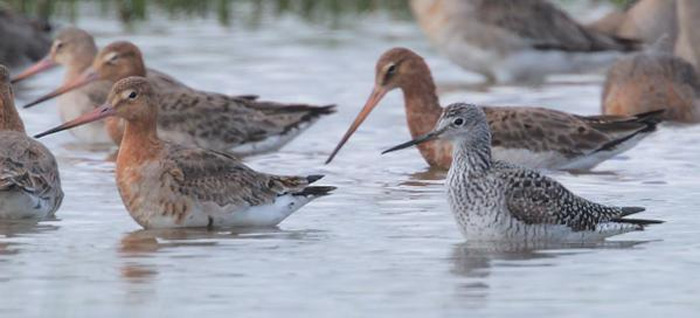
Making more comebacks than Elvis is the Titchfield Haven Greater Yellowlegs - clocking up visit #4 this week, seen on the local nature reserve for much of the day on 9th.
This second county record cropped up initially on January 11th before seconds were served on April 11th. Both of those dates were “singles only” but it was days rather than months until the next sighting - April 19th - with the bird remaining for two further days. After a “probable” was noted on April 25th, there was nothing again until this week and May 9th - this tricky individual lingering though until 7-ish before departing south once more.
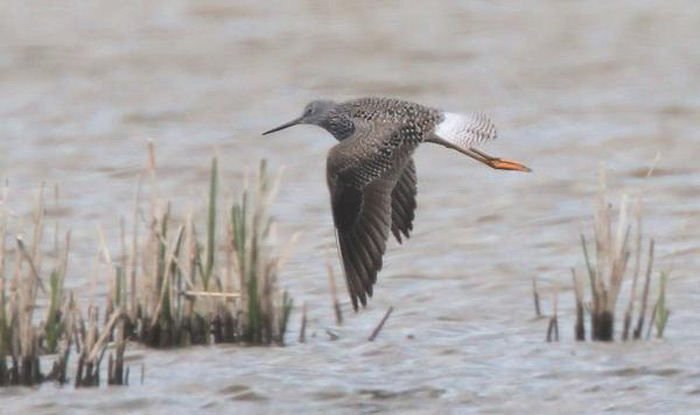
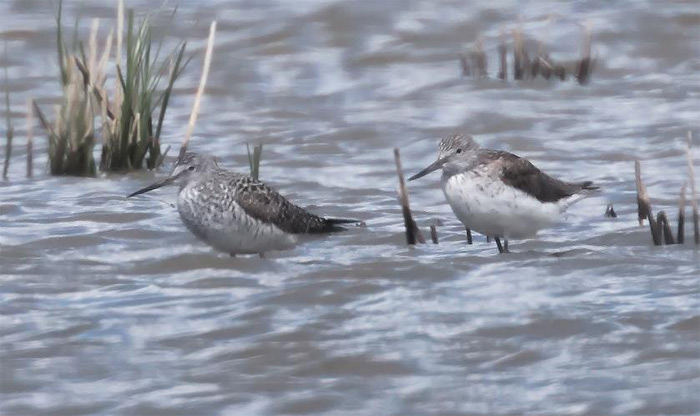
With so much going on elsewhere, it was easy to forget that one of the winter’s major stars was still hanging out in northeastern Scotland - the first-summer drake Harlequin taking his tally of days on site to 129 when he was noted along the River Don, on the outskirts of Aberdeen on 12th. That record total is now in sight…
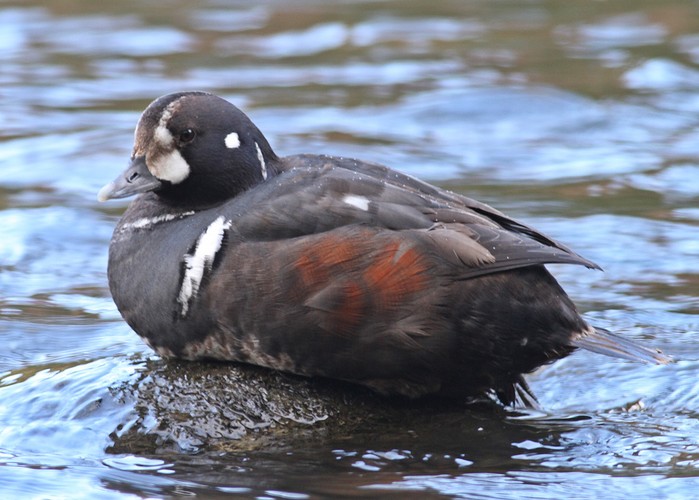
Rounding things off for this section, the early evening sighting on 12th, from on-board the approaching M.V. Scillonian of the summer adult Pacific Diver in Mount’s Bay - the first sighting off the week.
How much longer will it linger? That’s not a game I want play anymore…
Finally then, we come to the rest of the week’s birds…
May Grey Phalaropes may not have the same allure as Norfolk’s offerings this week, but they are certainly of some significance. Four were mentioned for the last seven days; three were seen from on-board the Uig to Lochmaddy ferry during the evening of 8th while a brief summer-plumaged bird was seen in flight over Stocks Reservoir (Lancashire) on 10th.
Another boat trip out in to the waters off Portsoy via the M.V. Gemini Explorer produced seven White-billed Divers on 9th with land-based singles on 7th and 10th. What may well have been a Portsoy bird was seen a couple of miles away at Sandend on 12th. Elsewhere, a couple more singletons were logged - the adult was again around South Ronaldsay (Orkney) on 6th-9th and another adult was noted from the cliffs at Cullen (Moray) on 8th.
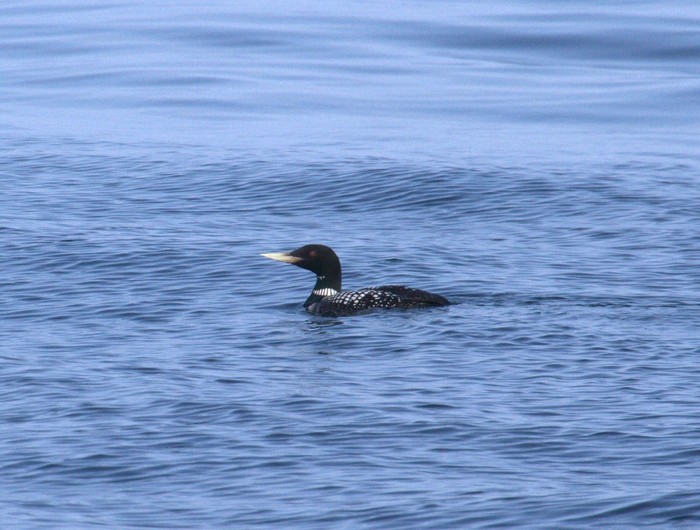
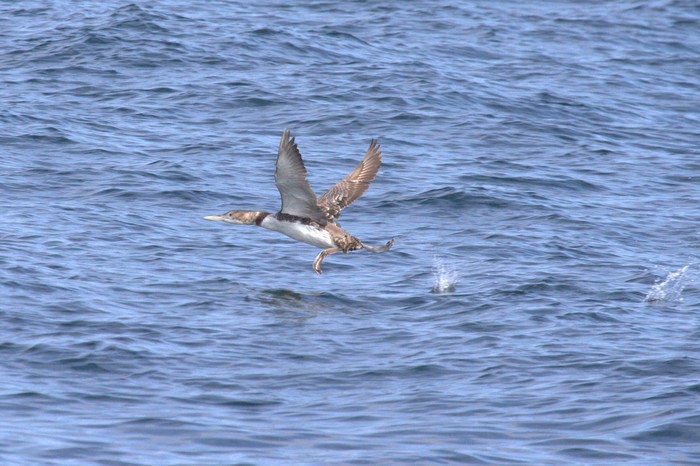
The first Long-tailed Skuas of the week were recorded on 7th, all from traditional sites; lone adults were seen heading across North Ronaldsay (Orkney) and Bowness-on-Solway (Cumbria) and two more were recorded from the Balranald RSPB reserve, at Aird an Runair, North Uist (Outer Hebrides) while 36 were counted passing over Esha Ness, Mainland (Shetland).
May 10th produced seven more for the Bowness birders and another was seen from Cork’s Galley Head while the 11th saw Orkney score another, on Burray before evening news reached us from elsewhere in Scotland; a flock of 20 were noted in Dumfries & Galloway, off Newbie and then came news from Aird an Runair - seabirders there having a cracking afternoon with 762 Long-taileds moving north between noon and mid-evening, along with 105 Pomarine Skuas too. Talking of which…
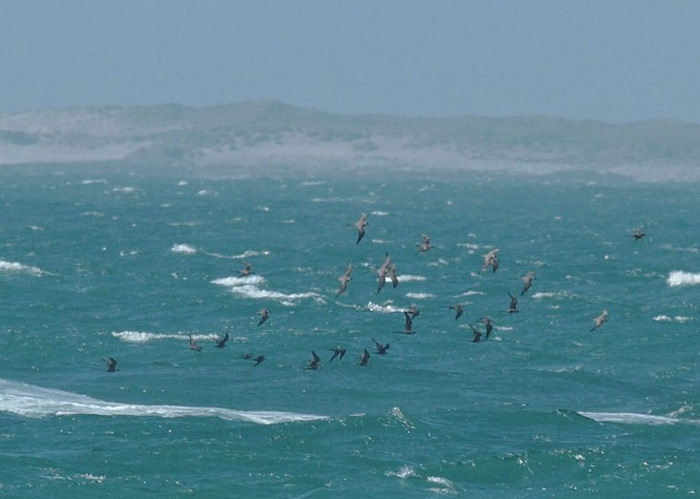
There wasn’t too much of a surprise to see the first day of the new review period being somewhat awash with a decent first springtime push of Pomarine Skuas - the coasts of England, Scotland, Wales and Ireland managing a combined May 6th total of some 199 birds in all. Some classic May skua days have managed that number at one site alone, but as an appetiser, this was a very tasty start…
Some 18 counties were involved - not all of them coastal - with highlights including 42 birds off Criccieth (Gwynedd) during the late afternoon; 31 (in just two groups) of Newbie (Dumfries & Galloway); at least 20 heading north past the headland at Troon (Ayrshire) during an evening seawatching session; at least 19 off Severn Beach (Gloucestershire); 14 from Aird an Runair, North Uist and with 13 noted from on board the Scillonian on the evening crossing back to Penzance.
A minimum 13 were seen off the Dorset coast, at Chesil Cove during the morning and oddments included the flock of six noted passing across Lower Lough Erne (Co. Fermanagh) and also strays over Greater Manchester’s Salford Quays and the dark “spooner” found during the early evening at Grafham Water (Cambridgeshire).
Election Day dawned with a swift 22 Poms from Portland Bill before 8am, with eight more trundling by soon after the hour too. A sprinkling of birds was noted on both south and west facing coasts, from West Sussex to Gwent with one making it past North Ronaldsay as well. Before noon had chimed, birders at Saltcoats, on the Ayrshire coast, had logged an impressive 84 birds in all before a count of 85 came in from Mangersta, Lewis (Outer Hebrides). Keeping the election theme to the fore - Ayrshire demanded a recount and, bingo! - up the tally went to a day high of 86. The Balranald skua watchers could manage 71 birds in all for the day with another 10 in Chesil Cove during the evening.
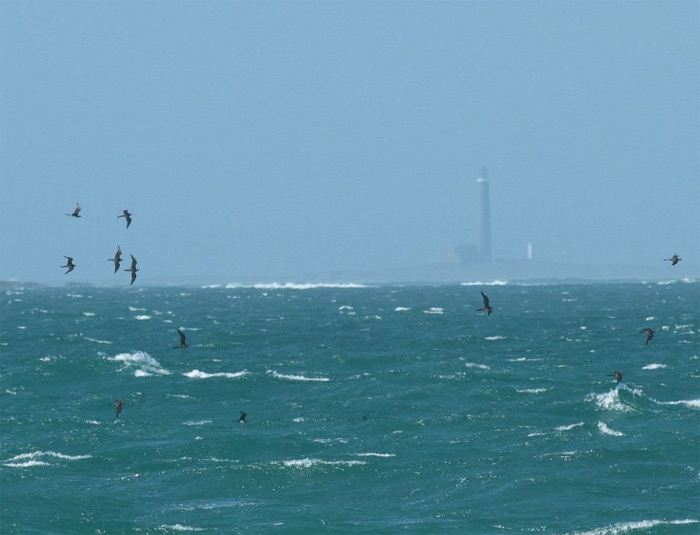
Numbers for both 8th and 9th were very similar - 48 on the former and 47 on the latter; 19 of May 8th’s birds were seen in Devon while around 20 of those seen on 9th were around Portland and Chesil Cove, with a further 13 passing by South Stack RSPB (Anglesey).
The second three-figure tally of the week came on 10th - Bowness-on-Solway seeing at least 50 fly through during the day, while in Ireland 24 were seen from Waterford’s Helvick Head and 25 were counted from two Cork headlands, the Old Head of Kinsale and Mizen too (10 at the first, 15 at the second site). Along with the three figure count from Balranald on 11th, other neat counts came from Bowness, another 25 there with 15 from Carnsore Point (Co. Wexford) as well.
The final day of the review saw more and more and more Long-tailed Skuas fly past Aird an Runair - 13.5 hours of watching yielding a magnificent 1,307 birds in all, along with 353 Poms. Very, very cool…
Also around North Uist on 12th, a flock of 57 Long-tailed Skuas flew over Committee Road, near Solas with 40 flying along the shoreline at Rubha Arnal. Smaller numbers elsewhere included one over South Uist, two off the coast of Cumbria, seven over North Ronaldsday and one at Yesnaby on Mainland Orkney.
…and along with the 353 Pomarine Skuas off Balranald on 12th, a further impressive count of 198 came from Mangurstadh, Lewis while away from the Hebs, 70+ were logged from elsewhere - from the Hebrides down to Devon, with 55 of them heading past Bowness-on-Solway.
Southwestern England hosted two Squacco Herons this week, one for west Cornwall and one for south Devon - doubling in a week the number recorded as a whole across 2014.
Cornwall claimed the first of the past seven days, seen just the east-northeast of Polgigga, at Bottoms, from 6th-11th - a bird which will become the 21st for the county, the 12th Cornish record for the month and the third Squacco in the last five years.
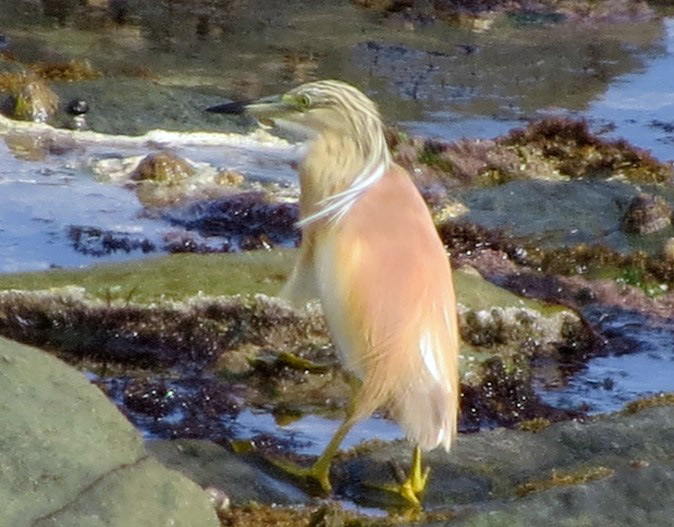
Devon birders got in on the act thanks to the discovery of an adult Squacco Heron on the rocks at Langerstone Point, at Prawle Point on 9th. The bird reappeared on 10th and again on 11th-12th, becoming Devon’s 14th in all, just the third for May and the first anywhere in the county since October 2005.
(…and, just in case you’ve ever wondered, as I did this week, just where the word Squacco derives from, it appears to be a 17th century word, taken from an old Italian dialect).
The pool on Lower Moors, on St. Mary’s, remained at the epicentre of all things Nycticorax for another seven days - at least four Night Herons (a second-summer and three or four adults) were counted as dusk fell on 8th and the two following days saw five counted on both evenings (at least three remained to duck on 12th too). Two more were reported on the English mainland - one in Lincolnshire, at Burgh-le-Marsh on 10th-11th could be the first in the county for seven years+, while the same date saw one reported from Colyton Common LNR (Devon).
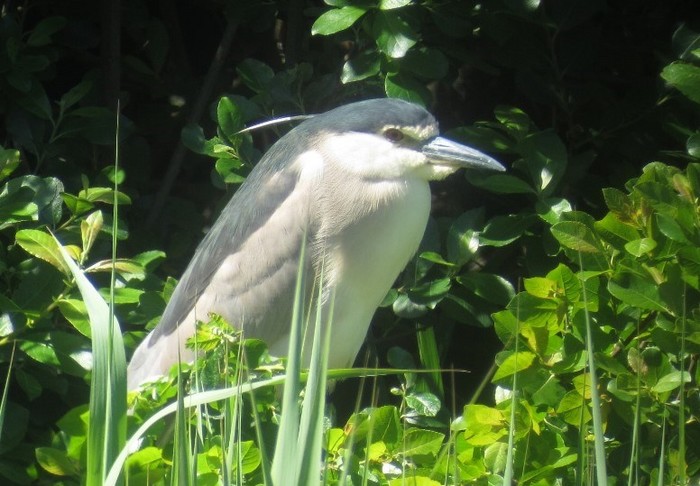
After the report of a possible 1w Purple Heron over the reedbeds at Lodmoor RSPB (Dorset) on 6th nothing more was heard for days and it seemed that nothing would come of the initial news. That changed on the evening of 12th when the bird was seen again and the identity was confirmed.
Kent held the only Cattle Egret of the past week - still around the Kenardington RMC bridge near Hamstreet off-and-on to 11th. Great White Egrets were rather easier to come by - at least 16 recorded on 11 counties. Five were seen at the Ham Wall RSPB (Somerset) on 9th, with a further four noted across five counties in the northeast of England; one was at Fairburn Ings (West Yorkshire) on 8th; another headed north from Scarborough (North Yorkshire) early on 9th and was probably the bird that then reached Cowpen Marsh (Cleveland) after lunch; on 10th, a Great White Egret was again at Huttoft Bank (Lincolnshire) and the 11th saw the region’s final bird noted at East Chevington (Northumberland).
There were two Great Whites for the Midlands (in Gloucestershire, at Severn Beach on 8th and in Northamptonshire, at Summer Leys NR to 9th) and in East Anglia, two were seen at Minsmere RSPB (Suffolk) on 9th and at Lakenheath Fen RSPB on 11th. Singles were seen at Dungeness RSPB (Kent) and in Scotland, still on the Loch of Strathbeg RSPB (Aberdeenshire) both to 7th and the final day of the review period saw the appearance of one over Leytonstone (London) and another noted again at Llanrhidian Marsh (Glamorgan).
There was just one Glossy Ibis up for grabs - still in Nottinghamshire, at Gonalston to 7th while the familiar conundrum as to just how wild the White Storks reported this week were loomed large. One bird that was present with captive birds at Flamingo Land in North Yorkshire on 7th (and which had been present for a week) was certainly “of unknown origin” while there’s no clue as to the legitimacy of the Stork seen over Cleveland and Durham on 10th (firstly at Billingham, then over Washington WWT and Castle Eden).
Norfolk recorded two groups of four Spoonbills - at Cley on 6th and Titchwell RSPB on 10th (six were seen at the latter site on 12th) with four more loner birds reported through the week. A further four were seen in Poole Harbour, at Lytchett Bay on 10th and these all went to make up a total of just under 40 in all. Three birds were at Pennington (Hampshire) on 8th, with two at Farlington on 11th, with further south coast birds seen in both West and East Sussex, with one also in Kent, at Pegwell Bay on 9th. Elsewhere on the east coast, Minsmere and Gibraltar Point scored two more twos through the week while inland birds appeared on 11th at Little Marlow GPs (Buckinghamshire) and the Cotswold Water Park (Wiltshire). On the 12th, a singleton was seen at Slimbridge WWT (Gloucestershire) while last of all, the immature Spoonbill was noted again at Tacumshin (Co. Wexford) on 7th-11th.
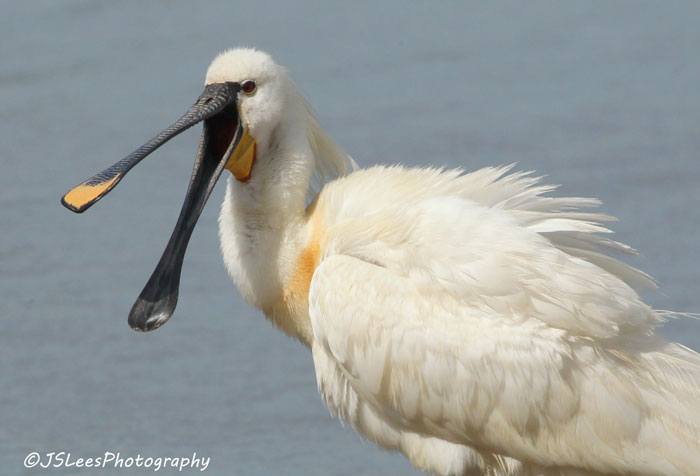
Before this week, Scilly had managed just two more Common Cranes than Great Blue Herons but the 4:2 ratio was upped in favour of dear old Grus thanks to Bob Flood’s murky find of a near-adult through the grey gloom of 8th - picked up initially in the meadows at Porth Hellick, before taking flight to the north. Soon afterwards it was seen near Newford Duckpond and then made one of several passes across Lower Moors. It wasn’t until late afternoon that the fifth for Scilly settled down, feeding happily in the wet meadows between Higher Moors and Pelistry.
The bird remained on St. Mary’s the following morning but warming temperatures and clearing skies saw it depart to Tresco before drifting over four islands (including St. Martin’s and Bryher) on 10th. The following day, the island-locked bird moved around between St. Martin’s, Tresco and St. Mary’s once again, presumably trying to find a way to the mainland. It hadn’t managed it by 12th, loitering in now-favoured fields on St. Mary’s…
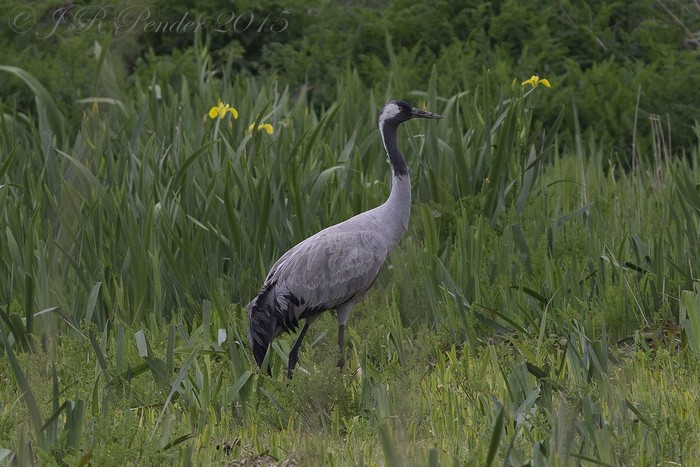
The island’s most recent Common Crane was noted in 2004 over Peninnis Head with previous records coming around the airfield in May 1995, on Tresco in 1989 and way, way back in 1851.
Rather more typical of the species’ movements were the threesome which headed along the north Norfolk coast on 8th, drifting over Stiffkey Fen and Kelling Heath with further records on the same day coming from Penarth (Glamorgan) and Steart WWT (Somerset), an individual noted specifically as being unringed. A group of four Cranes were reported in Hampshire, at Catisfield on 10th with two more dropping on to Shetland, at Waters of Raga, Mid Yell the same day, birds which then drifted down to Mainland the following day, seen at Cunningsburgh and then Levenwick. The final bird of the week was seen on 11th, at Upton Warren (Worcestershire) - and three released birds toured four counties in southern England, moving from Oxfordshire to Buckinghamshire, then Hampshire and Wiltshire.
Finally an honorary mention to the American White Ibis which surfaced again this week - noted on the scrapes at Holland Haven (Essex) on 12th - it was last seen in London on April 10th. Hide’n’seek clearly a favoured game for this one.
There’s just the one Lesser Scaup to mention this week - the nasal saddled drake that remained around the Anglers CP area, taking in Wintersett and Cold Hiendley Reservoirs through to 12th.
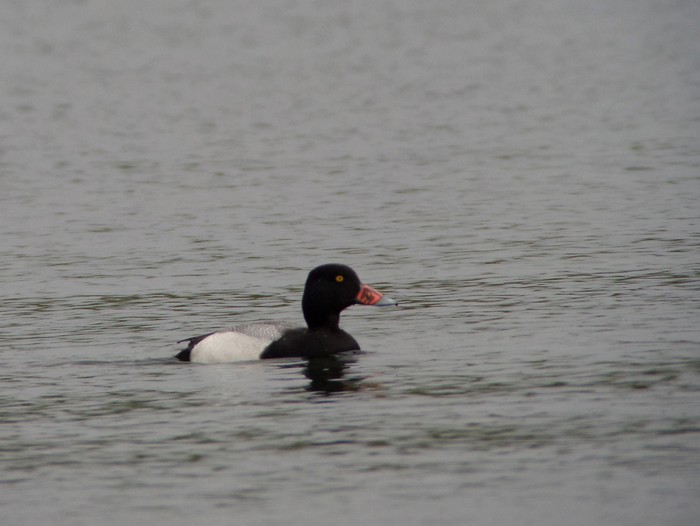
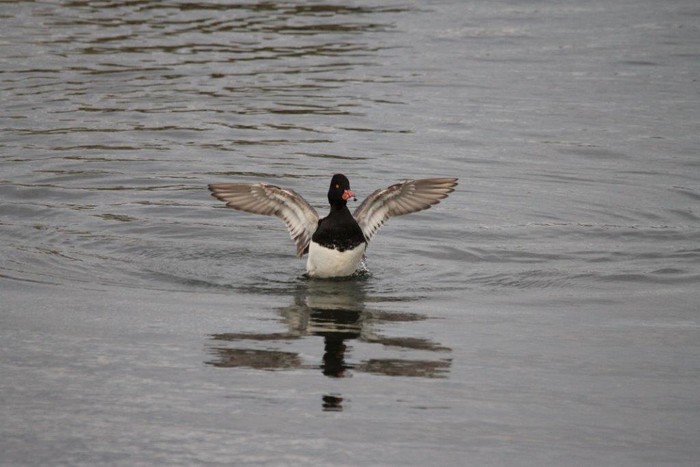
Going only one better were drake Green-winged Teals, two of those noted this week; the bird in Cambridgeshire remained on the Ouse Washes RSPB to 8th and on North Uist, one was again on Loch Sandary on 10th.
In Scotland, the sole Surf Scoter of the past seven days, the adult drake, was at Mussleburgh (Lothian) to 6th while the adult drake King Eider continued to pass the time on the Ythan Estuary (Aberdeenshire) throughout the week - his photogenic capabilities knowing no bounds…
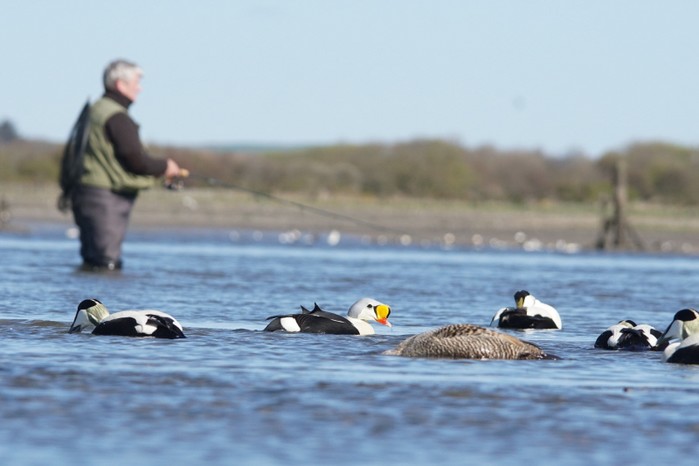
A typically low scoring week for our quacking and honking buddies is rounded off by the double bill of east coast Black Brants, again at Frampton Marsh RSPB (Lincolnshire) and on the Humber, at Spurn YWT (East Yorkshire), both on 11th.
Scotland may be awash with left-leaning SNP MPs (nice…) but it has never-ever been awash with Kentish Plovers so the news of a delightful male at Dornoch (Highland) on 7th would have been well-received by many Scottish birders. This obliging bird showed through to 10th - and is the only fifth KP in the country in the last 11 years.
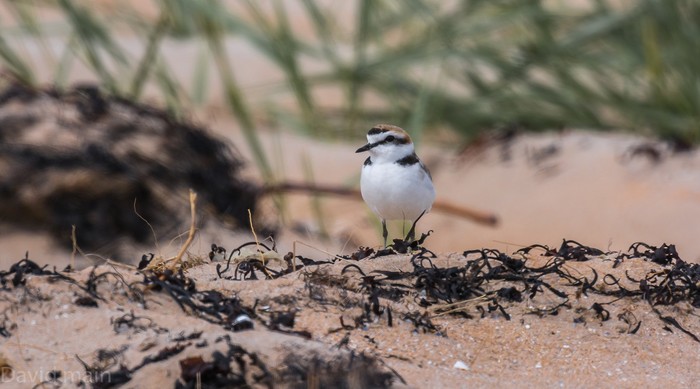
The same site, Dornoch Point hosted Highland’s only Greater Sand Plover, a striking adult male, for nine June days in 2011 - a Mongo will be next...
New on 11th was the Lesser Yellowlegs at Low Newton-by-the-sea (Northumberland); the first county bird since one at Druridge and Hauxley exactly seven years ago and the eighth in all. Keeping the ‘legs company was a new Pectoral Sandpiper, also found on 11th, one of three seen this week; one remained at Marshside Marsh RSPB (Lancashire) to 10th and another was found at the WWT National Wetlands Centre near Llanelli (Carmarthenshire) on 11th.
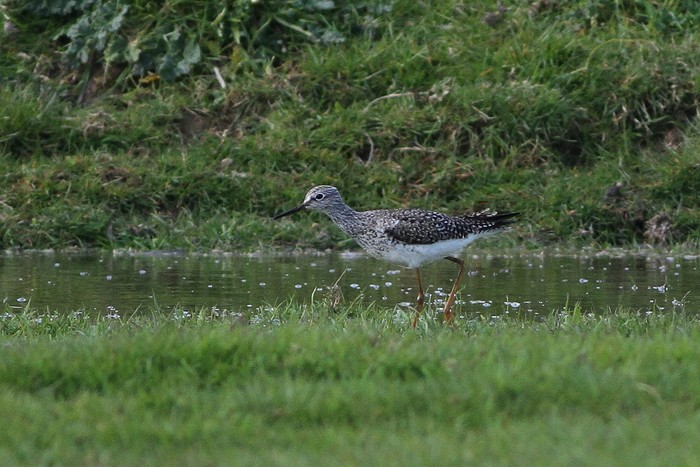
A female Black-winged Stilt was found on the marshes at Grove Ferry NNR (Kent) on 11th and still in place the following day, while the rough location of a suppressed bird in Lincolnshire finally became known (sort of) - seen near Grainthorpe on 9th (wher it been present for six days).
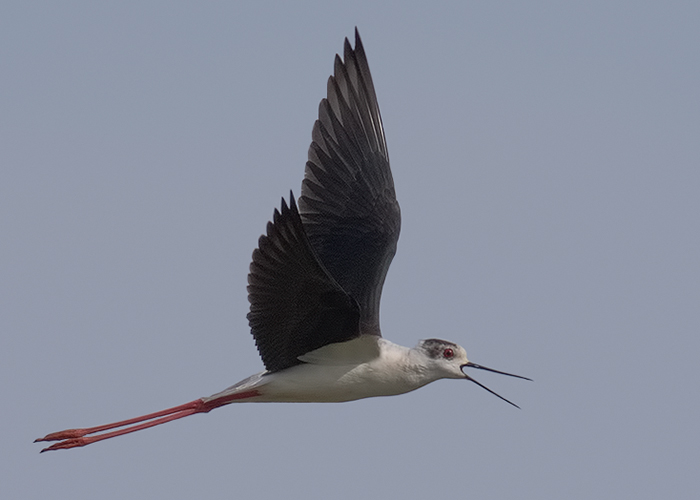
With the second week of May generally meaning Temminck’s Stint it was nice to see the tradition continue without fail - 22 birds reported from 10 different counties with Norfolk leading the way, six logged there, including three at Hickling Broad NWT on 9th and singles at Cantley Marshes RSPB on 7th and at Titchwell RSPB and Cley Marshes NWT on 11th. In neighbouring Suffolk, two birds were at Hollesley Marshes RSPB on 10th-12th and one made its way to Trimley Marshes SWT on 11th.
Away from East Anglia, three Temminck’s were at Staines Reservoirs (Surrey) on 7th, two were at Frampton Marsh RSPB (Lincolnshire) on 8th and further singles were spread far and wide; one was around the Saltholme reserve in Cleveland from 6th-11th; three singles were logged in East Yorkshire, near Tophill Low NR on 8th and at Flamborough’s Thornwick Bay and also Stone Creek, both on 9th; in the Midlands, loners were at Rutland Water (Leicestershire) on 8th-9th and at the Venus Pool (Shropshire) on 10th; the Home Counties saw the appearance of a single Temminck’s Stint at Meadow Lane GP on 8th and in Wales, Ceredigion registered another at Ynys-hir RSPB on 11th.
Another traditonal May bird is, of course, Dotterel and a couple of very groovy trips have been logged this week; 24 birds gathered at Choseley (Norfolk) on 10th (with 21 there the following day) and an impressive 29 congregated at Westmuiir (Angus) on 10th. Another 12 were at Garreg Lwyd (Carmerthenshire) on 7th and 11 flew over Donna Nook (Lincolnshire) on 12th, helping to boost the overall tally to 100+ for the past seven days.
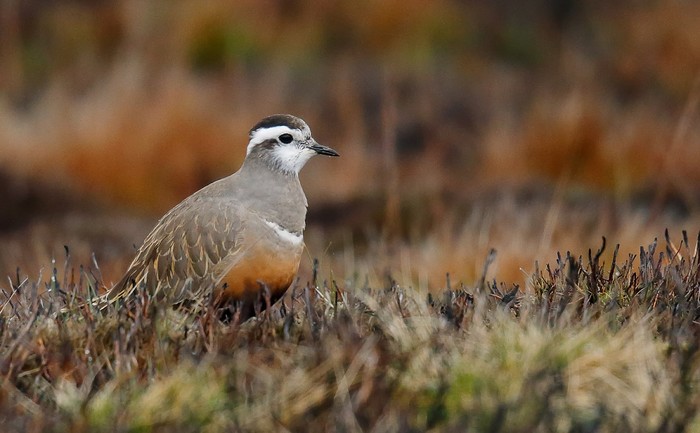
The other birds (all noted in single figures) were spread from Orkney, the Outer Hebrides and Argyll & Bute down to Lincolnshire and Norfolk, with Welsh birds in Anglesey and Conwy and included a smaller trip of five Dotterels at Cockersand Abbey Farm (Lancashire) from 8th.
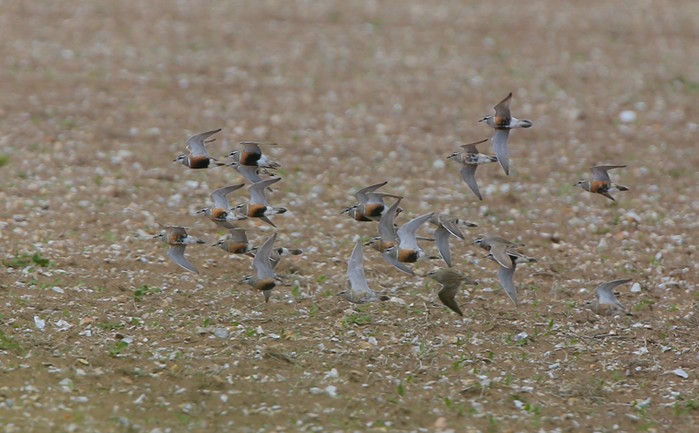
The English south coast played host to two first-summer Bonaparte’s Gulls this week - the bird found last week in Hampshire, in Southampton, was present through to 12th while the second individual was noted at Bowling Green Marsh RSPB (Devon) on 9th-10th (the second of the species for the county this year). Across in south Wales, an adult Bonaparte’s Gull flew across Llanrhidian Marsh (Glamorgan) on 12th.
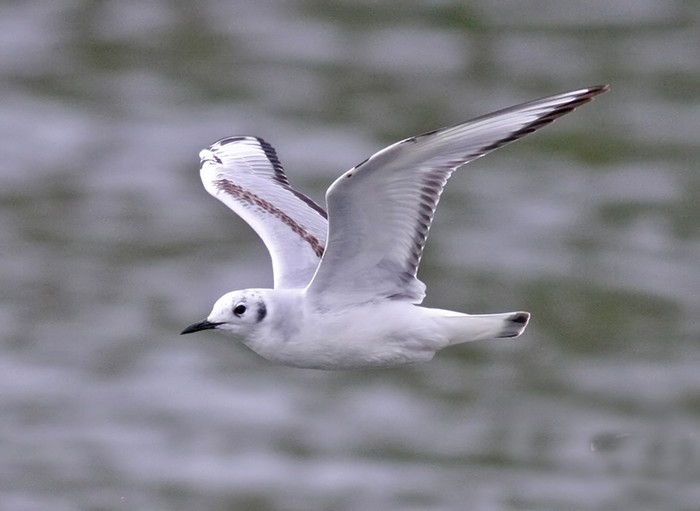
Ring-billed Gulls were represented by a report from Burton Mere RSPB (Cheshire) on 7th - the bird unaged and not seen again - a second-summer at Rosscarbery (Co. Cork) also on 7th; a ten minute report of a first-winter at Crosby Marina (Lancashire & North Merseyside) with the Cornish first-summer seeing them all out, still in place along the Hayle Estuary until 12th.
A further drop in Glaucous Gull numbers was to be expected, down three on last week’s total to 15 for the past seven days. As has been the case for weeks, Scotland fared best, 11 in all, with three around the Hebrides and two’s for Argyll & Bute, Moray, Orkney and Shetland. Two birds were seen in the northeast of England, in West Yorkshire and Cleveland, one was noted in Lancashire and the final one this week was still at Carnsore Point (Co. Wexford) on 10th.
Also dropping a touch this week were Iceland Gulls, some 35 recorded (compared to 45 seven days ago) with a figure of 26 for Scotland, which included nine on the Outer Hebrides (three of them in Stornoway Harbour on 7th), six on Orkney (with three at Yesnaby on 10th) and three singles around Shetland. Ireland held on to eight in all, with three still on Malin Head (Co. Donegal) and two in Mayo while numbers everywhere else were on the low side of low - four in the northeast and one a piece for the northwest and East Anglia.
Finally, last week’s juvenile Kumlien’s Gull at Loch Stiapabhat, Lewis was this week only representative of the form - still in place on the Hebs to 8th at least.
The mountains of County Fermanagh were the place to be for the stunning female (or possibly immature male) Snowy Owl that was discovered some 12 miles southwest of Enniskillen at the Gortalughany Viewpoint on the Cuilcagh Mountain on the morning of 7th - what a bird! As well as being an absolute cracker, this was also a huge bird in the county, being just the third-ever for Fermanagh - the only accepted record to date was seen in the mountains near Lack in February 1876, while mouch more up-to-date was the immature male reported twice from the Pettigo Plateau in February 2013.
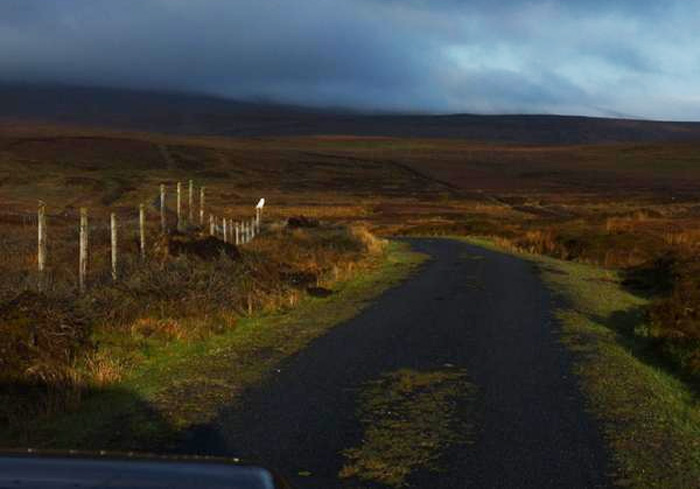
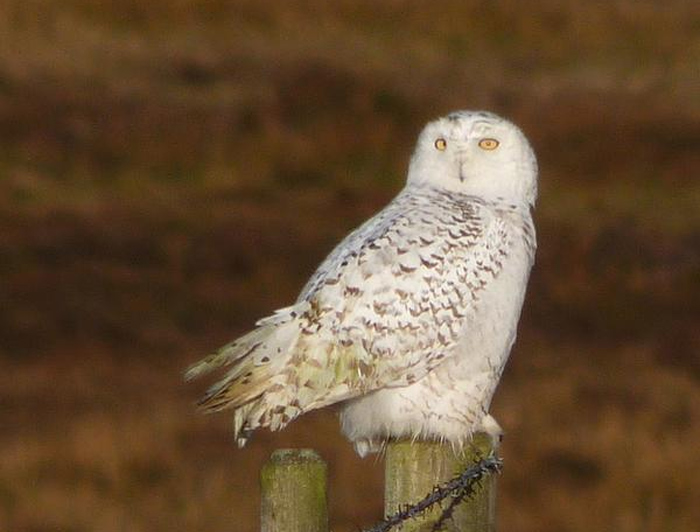
Kent was the county to host the only Black Kite this week, seen and photographed over the viewing ramp at Grove Ferry NNR on 9th. Four newly arrived Honey Buzzards were also reported this week - a male was seen over Rigg Bay (Dumfries & Galloway) on 6th, one was seen over Ipswich (Suffolk) on 7th while on 9th, singles headed across The Naze (Essex) and Maesbury Marsh (Shropshire). The final report came from Pegwell Bay (Kent) on 12th.
The two Montagu’s Harriers continued to show throughout much of the week at Blacktoft Sands RSPB (East Yorkshire), seen through to 11th at least. Further records this week came from Romney Marsh (Kent), where a ringtail flew north on 7th; a male was seen at Holme-on-Spalding Moor (East Yorkshire) on 9th with another (presumably a Blacktoft bird) drifting over Alkborough Flats (Lincolnshire) the same day; and in Suffolk, wheer a male flew over the Benacre estate on 10th.
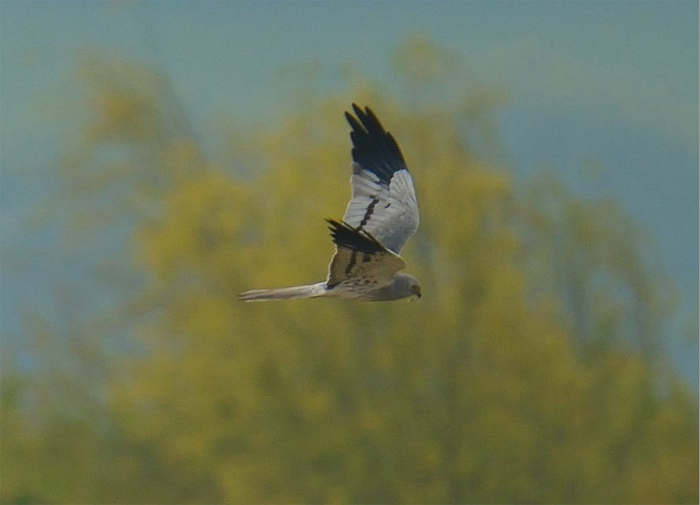
It is highly temptiong to link together the Northern Isles sightings of Rough-legged Buzzards on 8th - one was noted briefly at Hooking, on North Ronaldsay (Orkney) just after noon, two hours later one was seen over Fair Isle’s Buness. It must be one in the same! Elsewhere in Scotland, a Rough-leg was seen at Cabrach (Moray) on 9th while East Anglia held the other reports for the week; in Norfolk, single birds were seen near Caister on 9th, again at Winterton on 10th and Breydon Water on 12th, while Suffolk held one at Carlton Marshes SWT, also on 9th.
Last week El Passerinos began with the dazzlingly-fine male Red-throated Pipit in the hills of Derbyshire. This week we’ll began with another rather snazzy looking RTP - this one taking some time to enjoy the industrial surroundings of Cleveland’s Seaton Common, present from 10th-12th. Prior to departing the Rarities List in 2005, the county had managed just five accepted records of the species; a further four have been reported since then - the most recent of those coming in October 2015.
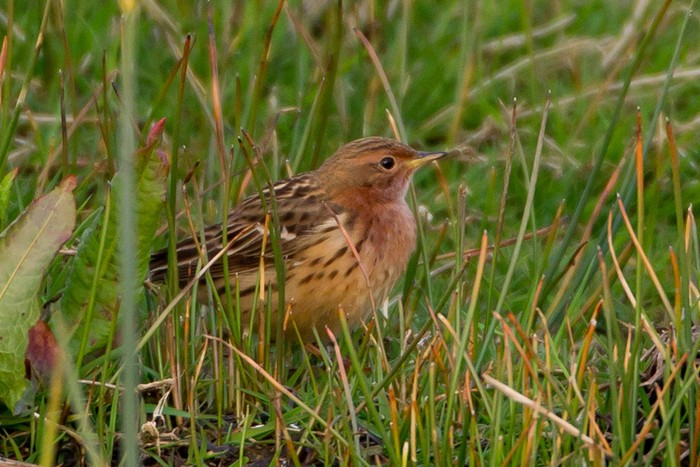
The second Tawny Pipit of 2015 (and May itself) was found in the Crown Estate Fields at Portland (Dorset) on 9th, being seen again the following morning too. Last week’s first-of-the-year on Fair Isle remained to 6th.
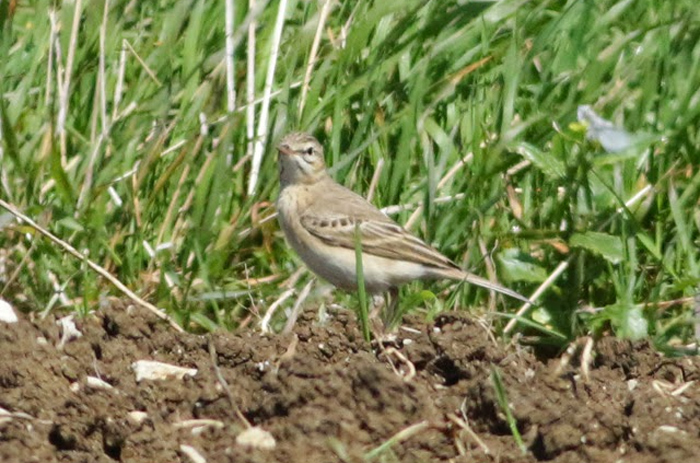
Another year 1st will be the (if accepted by the county records committee) early-ish Melodious Warbler that was reported from the woods of Thorpeness (Suffolk) on 8th - it could be the first May record since a singing male in London in 2012.
Time to get the coloured pencils, crayons and paints out now for some exotic splashes of much-needed spring colour - Bee-eater starts us off and the first of the week was seen on wires at Hatton, near Warrington (Cheshire) on 6th (still a very rare bird in the county). A couple of heard only birds followed over the weekend (in Oxfordshire, at Farmoor on 9th and in Norfolk, at Winterton on 10th) with “seen” individuals noted on the latter date from two points in Suffolk, over Covehithe Broad and later Corton while in East Sussex, two Bee-eaters flew in-off at St. Leonard’s on Sea at lunchtime. Two more were reported from Grantham (Lincolnshire) on 12th.
In East Yorkshire, the Red-rumped Swallow found last week Hull remained at the East Park until 7th and was one of seven recorded in all; on 7th new singles were found at Selsey Bill (West Sussex) and Covenham Reservoir (Lincolnshire); the 9th saw one fly over Porthcurno (Cornwall) and on 10th new singles were found at Catsford Common (Somerset) and Ferry Meadows CP (Cambridgeshire), the latter still present to 11th and one spent a few minutes at Cley (Nordfolk) on 12th. Back briefly to the 11th when a Red-rumped Swallow was noted heading south over The Warren at Spurn…
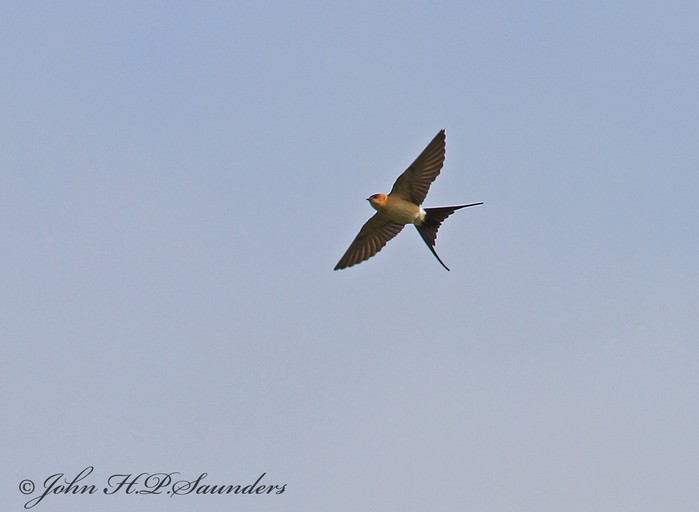
...talking of which, the very same site also held an Alpine Swift this week, seen for almost half an hour before heading south across the Humber. It was followed by a single roaming bird in West Yorkshire, first noted at Ilkley on 8th before relocating to Pugneys Country Park on 9th. The most significant Alpine Swift of the week, certainly for those who spied it, was the bird seen over Blacksod, on the Mullet on 12th - a potential county first for Mayo.
Its been a lean week for Woodchat Shrikes, only the three to mention, one of which, the male at Ballycotton (Co. Cork) was leftover from last week’s fun-fest. He was in situ all week, while the bird at Porthgwarra (Cornwall) was seen on 8th-12th (and could even be the bird first noted there in late April). Definitely new was the Gugh male, found in the hedgerows on this cute Scilly islet on 12th. Also this week, an early-ish Red-backed Shrike was reported from the Isle of Skye, a male seen in gardens at Portnalong on 7th.
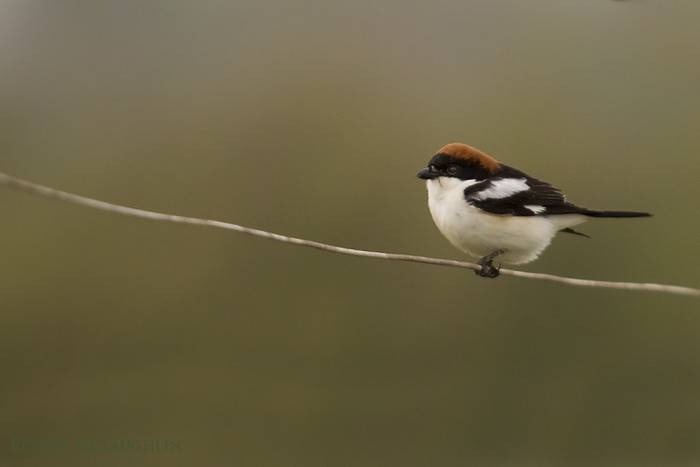
Whilst there may have been slim pickings for Woodchats, the past seven days have been particularly strong for Golden Orioles with small flocks recorded at more than one location…
Starting on the Isles of Scilly where singles on St. Agnes and Bryher on 6th gave a golden glimmer of what was to follow. A flock of at least five was seen on St. Martin’s on 5th (with a further two on the island on 10th), while singles on St. Agnes and Gugh on 10th were beaten by four at Trenoweth, St. Mary’s on the same day, with a single and then two more on Mary’s to the end of the review period. Also on Scilly on 12th, at least two Golden Orioles were on Gugh and five were noted around St. Martin’s (for the second time this week).
Portland did very well too - four were seen in trees near the fire station by Grove Road on 10th and two more were seen at Wakeham the same afternoon and the following day saw two in the Top Fields on the Bill itself. Further flocks of Orioles were the foursome on Skomer Island (Pembrokeshire) on 11th and the three on Lundy Island (Devon) on 10th while 12 further singles were logged from Orkney to Dorset - including three in Norfolk, two in Suffolk (including a one-day singing male at the old breeding site at Lakenheath Fen RSPB on 7th) with two further singles in Dorset - the weekly total being pretty adjacent to an ultra-impressive 45+.
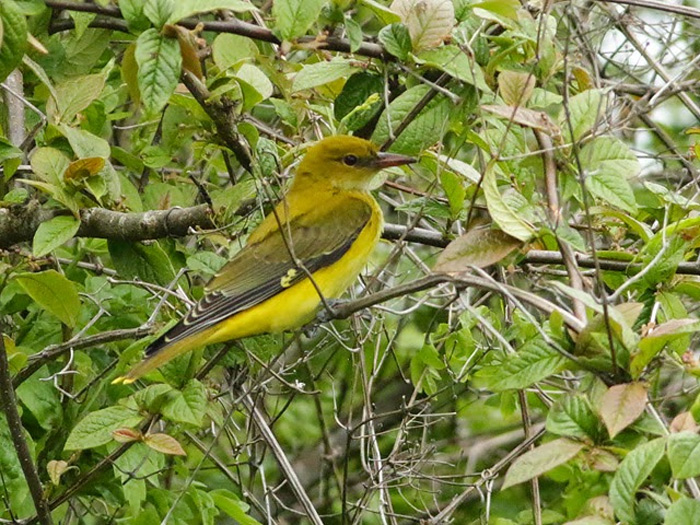
County Cork scored at least three (probably four) new Hoopoes this week; seen near Skibbereen on 8th and at the Old Head of Kinsale and Ballycotton on 9th with another (?) in gardens at Kinsale on 10th-12th. English singles were noted at Stratford-upon-Avon (Warwickshire) on 7th, Stokes Bay (Hampshire) and Weymouth (Dorset) on 8th, Falmouth (Cornwall) on 9th and, back in Dorset, reported from Bournemouth and Throop on 11th and 12th (the latter being heard only).
Also reported on 12th, singles in gardens at Sutton-in-Ashfield (Nottinghamshire) and Wichenford (Worcestershire). Scotland also saw one Hoopoe reported - seen a couple of miles south of Tomintoul (Aberdeenshire) on 9th.
Fair Isle gets the Wryneck ball rolling this week - one there on 6th with what may have been another on 10th-11th. Scilly managed a single on St. Martin’s on 8th with three further singles logged through the past seven days, at Barns Ness (Lothian) on 9th, in Northumberland, on Holy Island, on 10th and to round the week off, on 12th, in Norfolk one was seen at Holme and in Surrey, on Thursley Common.
Nipping back to St. Martin’s where a very busy, birdy 8th (courtesy of a murky south-east wind) also produced a Short-toed Lark, one of two seen on the same date, the other arriving on Fair Isle - both birds present to 11th.
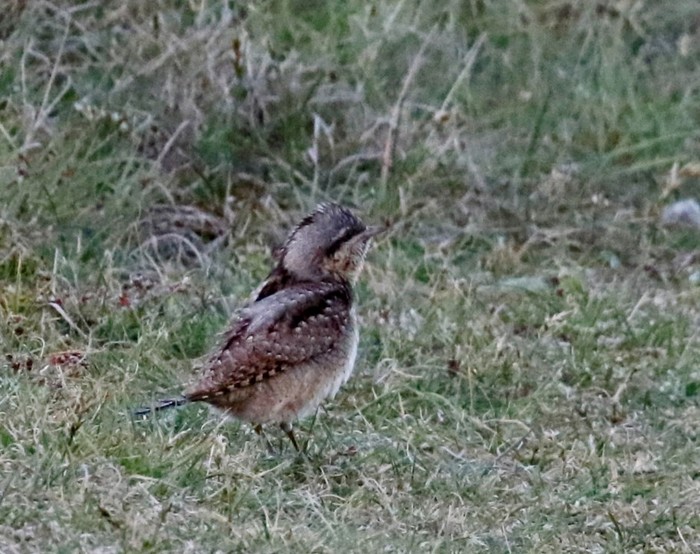
Last of all, we’ll end on Scilly where, along with the local Mega in the giganto forn of the big boy Grus, a second huge island bird, a singing male Cirl Bunting was found at Trenoweth on St. Mary’s, late in the day on 10th where it remained only until the early morning hours of dawn the next day. It seems as though views were extremely hard to come by - which is shame for such a corking bird. Once accepted by the loal records committee, it will become the 7th for Scilly and the first since a flock of 12 were seen at Borough Farm, St. Mary’s in January 1977.
A slightly bonkers week draws to a close - seven days which saw a two-tick 24 hours for many birders (some with really rather large lists). After what was a rather quiet start to the month, May has blasted right back at’cha…
The deeper we bury ourselves in this Spring Month Supreme, the expectation ratchet up further and further. The variety and spread of rares is extraordinary - as a for instance May 13th boasts the first recent twitchable Barrow’s Goldeneye and Lesser Kestrel (on the Ythan and St. Mary’s), along with the likes of Trumpeter Finch, Alpine Accentor and Calandra Lark - I’ll keep predicting one of those until June…
The list of outstanding historic rarities continues throughout the week - picking one bird per day there’s the Stronsay Cretzschmar’s Bunting on May 14th 1998; May 15th 1991 brought us the Waxham Lark Sparrow and in 2013, the Margate Dusky Thrush - yes I said one, but hey…; Britain’s most recent Wallcreeper flew “in-off” at St. Catherine’s Point (Isle of Wight) 30 years ago to the day on May 16th 1985; the first accepted Northern Mockingbird appeared on Horsey Island (Essex) on May 17th 1988; a male Myrtle Warbler landed near Fair Isle’s South Light on May 18th 1977 and the famous Church Norton Trumpeter Finch was discovered on May 19th 1984.
…and that’s just a mini selection…
More likely are the likes of Citrine Wagtail (where are they this spring?), a rare marsh tern or two, maybe a funny crake or a Terek Sand while we begin to await the news of the first Thrush Nightingale and Blyth’s reed Warbler for 2015.
This week has proved, beyond all doubt, no matter how quiet it may seem, someone, somewhere is just about to stomp on the birding equivalent of Neil Young’s big red “whizzer” and make it all go very loud, very quickly.
Birding remains the rock’n’roll branch of ornithology!
Mark Golley
13 May 2015
Please check out our contributor's websites for more superb birding photos, videos and more.
 |
|
||||
 |
|
|
|
||
|
|
|
|
|
||
|
|
|
||||
|
|
|
||||
